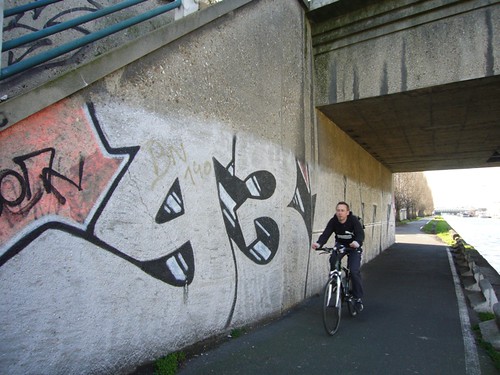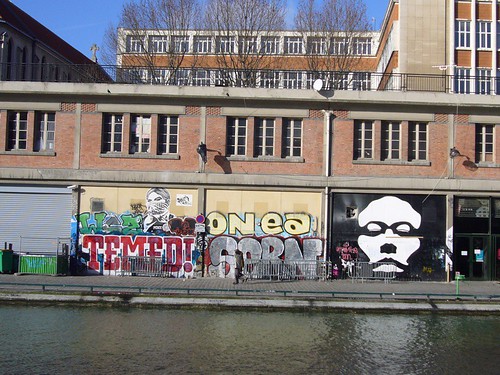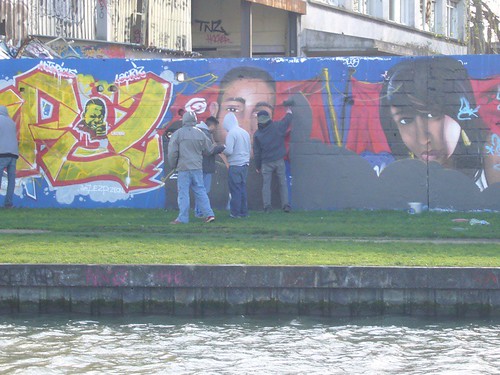21/01/07
Sunny Sunday – cycling and les techniques du corps

Cycling in the banlieues, neuf-trois (93)
Many months ago, I mentioned that I wanted to write about cycling in Paris versus Oslo, from the perspective of Marcel Mauss’ techniques du corps (available for download in French here). I’m reminded of this old classic each time I go from my Norwegian bike to my French one. Most bikes in Norway have an extra angle on the handle, putting it more in front, thus making the cyclist lean more forward. In Paris, the cyclists sit with their back straight. The majority of bikes in Oslo are some kind of – rather fancy – sport bikes. In Parisian streets, the sport bikes are rare, and you see men and women cycle on anything on two wheels – men on what usually is considered a woman’s bike are for instance not unusual. (And sure, after having my foldable, and expensive indeed, bike stolen after just a couple of months, the last thing I want is a new fancy looking one. What I’ve got now is a cheap retro looking inconspicuous one, – which a friend immediately condemned as bourgeoisie-looking. My only justification was that it was the cheapest I could find.)
In addition to leaning forward on their seat, many Norwegian cyclists use a helmet. Surveys show that cyclists with helmets are more likely to suffer serious injuries, - obviously because they cycle faster. And of course the cyclists in Oslo – forward leaning and with sport bikes – cycle far faster than their Parisian counterparts. Here’s of course the connection to les techniques du corps, where Mauss in 1934 described how what we think are “natural” ways of moving the body, are highly social (physiological + social + individual (or psychological), I think he writes.
I often think of cycling in Paris as a flâneur-like activity, -as the bike itself and the way ones sits, in addition to some general mood, perhaps, don’t encourage one to cycle very fast. The pedestrians also are generally strolling around rather than hurrying. And if someone hurries past you, you very often hear a pardon - yesterday the person in hurry even bothered to turn around to excuse himself to me face to face.
If cycling in Paris has a character of flânerie, in London it’s closer to extreme sport. In Oslo I’ve until now thought of it as simple transportation, but after having read Dag Østerberg’s socio-material analysis of Oslo I realise that our way of everyday city cycling can be read as a an example of our “naturalness”. On my bicycle trip along the canal far into the suburbs today, I noticed that many Parisian cyclists put on helmets and sports gear and get their sport bikes out the cellar in order to go out of the city, as a Sunday activity. In Norway, fast cycling with helmets takes place inside the city. Østerberg writes about the Norwegian bourgeoisie (my translation):
The distinguished naturalness is a characteristic of the women and men of the Norwegian bourgeoisie: They engaged in sport and open-air activities to a far more than the rest of the European bourgeoisie. No other bourgeoisie lives in a forest (Østerberg 1993: 48-9). (For those who are interested, an additional explanation follows in an extended quote at the bottom of this post).
This “naturalness”, in perhaps less “distinguished” versions, permeates the Norwegian society. I wonder if it’s that which makes street life in Norway less communicative, less filled with meaning/significance, thus not social situations, while here in contrast, such small situations are “cultivated” into a little grain of social interaction. One example is the man saying sorry for just walking quickly past me in the street. “How many doors have you got in the face today,” is a standing joke at the Centre Culturel Français in Oslo, as many Norwegians ignore if someone is coming behind them through the door. It’s a lack of politeness, of course, but it’s also a lack of acknowledging that you are interacting with others in a social environment. The notion of living together “vivre ensemble” is everywhere here in Paris; from a core value at school to municipal politics.
I notice that I’m deviating a little from my sunny Sunday bike trip now, and I’ll end this post with one more comment on socio-materiality. It’s so flat to cycle here that I didn’t realise where I was until I was far out in the in the banlieues in Seine-Saint-Denis. However, what I had noticed was that the highly varied east Parisian street art suddenly had turned to pure graffiti “pieces”, and at times even tags and simple scribbling were predominant.

Street art and graffiti at Canal Saint Martin (75010)

Graffit artists at work in Seine-Saint-Denis
More photos from "neuf-trois" here
When I got back to Paris, I passed Place de la République, and guess what? There were police as well as demonstrators present. (This time it was an anti-abortion demonstration).
---
The nature impression of Oslo is strengthened by the fact that parts of the economic, political and cultural ruling strata live in the hills, among trees and forest. These strata legitimise themselves party through “nature” and naturalness, in contrast to what is the case in many other countries. The bourgeoisie legitimised themselves from the 18th Century by appealing to “nature”, that we are born equal etc. The powder perukes and the rest of the baroque and the rococo were seen as unnatural, and were consequently left behind. However, around 1850 this changed. The bourgeoisie discovered that nature was and “vulgar”, because one found it among the farmers and the threatening labour movement. From now on, the bourgeoisie legitimated themselves with cultivatedness, with manners in contrast to raw nature. The bourgeoisie of Oslo and the leading stratum, on the other hand, still legitimises itself partly with nature, houses with a forest, Tyrol-looking houses, cabins in the mountain, long cross-country skiing trips. More precisely: It legitimises itself with distinguished naturalness, with carefully prepared natural look (my – quick, sorry – translation, Østerberg 1993: 114).
7 comments
Hi Cicilie,
I just wanted to say how amazing your photos are! You always seem to be in the right place at the right time - I love the guy cycling through the tunnel and the artists you’ve actually caught at work. I’m in London at the moment and am very struck by some of the comparisons you make. Firstly I’m riding my Dad’s bicycle, a man’s racer with drop down handle-bars and it is definitely an extreme sport! I, like most of my friends here, pride myself on how fast I can criss-cross London on a bike, beating the public transport system. One friend of mine who started cycling to get to work has just taken up semi-professional racing after getting into it with his boss - it’s hard to imagine that in Paris! He also recently was set a challenge; could he get round the route of the circle line faster than a train (he did). I think what I’m trying to say is that a) there’s a certain macho quality to (some)cycling in London (although not to the exclusion of women) and b) that it also has a subversive dimension, allowing us to rediscover and reclaim our city from the congestion and the overpriced public transport network.
Also, as the gap between artists such as Banksy whose work sells for vast sums and the ‘taggers’ grows, graffiti in London is also increasingly an ‘extreme sport’ and one that sometimes costs lives. See this article from Saturday’s Guardian: http://www.guardian.co.uk/crime/article/0,,1994683,00.html
Very briefly it strikes me that whether it’s cycling or street art we’re talking about, in London it’s less about creative expression or making the most of the moment, and more about fighting, in a city where public space is being privatized all the time and where we are more under surveillance than anywhere else in the world, to preserve our access to the small modicum of space that remains (in tube tunnels, on the edge of the street and so on).
Mary
Hi Mary,
Thanks for your thought-provoking comment from London, which is just what this comparison needed. I haven’t cycled in London after Livingstone came to power, but it doesn’t seem to have changed much. I recognise very well the subversive element of cycling you point to. In the quite “alternative” flat-share I lived, to cycle was almost as important as to be a vegan/vegetarian. While in France, cycling is quite mainstream (however not very widespread), vegetarianism is ridiculed even on Indymedia and the whole idea of an “alternative culture” hardly seems to exist.
(In France, revolt and anarchism as well as notions of “creative expression and making the most of the moment” seem to be spread out more in a continuum. Someone mentioned to me that there aren’t really cultural differences between the generations in France, for instance Georges Brassens and Léo Ferré are equally popular amongst (certain strata) in all generations. Perhaps one can say the same about values and orientations that in Norway or Britain would belong to subcultures?)
The connection you make between graffiti and cycling as a subversive fight for a space is very interesting, indeed and it can reveal interesting differences and similarities between policies and attitudes in the three countries. Cycling does not have subversive connotations in Norway – doing sports and keeping fit (and arranging Olympic (winter) games) is fundamental in the national imagery; photos of Muslim women jogging with a headscarf is a popular symbol of “successful integration”. Norwegian Pakistanis cross-country skiing in the mountains is, however, a little more contested. Graffiti on the other hand, is prosecuted the same way as in Britain (thanks for the link to the Guardian article!), consequently making it a (dangerous) sport just to tag your name. Though I don’t think that legislation is part of anything like the British “Anti-Social Behaviour Act”, which is another very interesting aspect your comment pointed to.
Cicilie
Hi Cicilie!
A very interesting post! The comparisons you make between Oslo, Paris and London are exiting to read. I just have to comment upon your explanation to why cyclists with helmets are more likely to suffer serious injuries; I read about a norwegian study on the topic - the conlusion was that drivers didn’t keep the same distance to cyclists with helmets as with those without (they had actually measured the distances). Ok, I know that my comment is quite ad hoc, but any way….
Hi Monica,
Thanks for the correction. I’ve always thought that it was the cyclists themselves who became a bit more careless when they put on a helmet (I’ve heard some say that as well), but what you say makes sense. It also questions my claim that cycling isn’t seen as subversive in Norway. I wasn’t completely sure if I was going to write that, as one can certainly feel like a hair in the soup to many drivers back home. When I told a local that Parisian (and Marseillais) drivers pay more attention to cyclists than their Norwegian counterparts, he couldn’t it. It is really true, and I wonder why. Is it because everything - cyclists, cars, buses, pedestrians, tourists - usually moves slower here so they have time to notice small cyclists? Is it because the traffic is far more complex with all kinds of unexpected things turning up all the time?
Hi Cicilie,
a note from Décines (10 kms from Lyon).
Cycle tracks exist here, but are rarely used - even spurned by the serious sports cyclists who keep to the main road whilst kitted out in local team colours. Those who do use them are predominantly the teenagers to avoid clashes with cars.
But then, once a year, the roads are blocked off for the great social cycle event of the year. Thousands of cyclists then dig out bikes from ’somewhere’in a great display of community action to promote the positive benefits of cycling. Helmets are worn by many; youngsters dash round the course in a wild race; the middle-aged cruise and free-wheel keeping parental eyes on the smaller children. The course is about 10kms and once completed aperitifs are enjoyed as a brass band sounds out its ‘oom-pa-pas’.
Finally, as the slower cyclists trickle in, the first arrivals begin to trickle home. Bikes are then replaced in their ’somewheres’ to wait 356 days for the next sortie and show of community good-will on environmental concerns.
Just an observation after reading your text.
Hello,
I’d like to buy an ad on your page:www.antropologi.info/blog/cicilie/2007/sunny_sunday_cycling_and_les_technique_d
The ad would be for a website about triathlon. We will be providing you with the codes.
I don’t have a huge budget, but I’m sure there is a reasonable price we can arrange.
Please get back to me if interested.
Thanks!
Jessica
I definitely wanted to develop a simple note to be able to thank you for all of the magnificent hints you are sharing here. My time consuming internet investigation has at the end of the day been compensated with awesome facts and techniques to talk about with my great friends. I ‘d suppose that most of us site visitors are very blessed to live in a notable network with very many perfect individuals with valuable guidelines. I feel very fortunate to have come across your entire web pages and look forward to really more cool minutes reading here. Thanks once more for a lot of things.
| « Slameurs - and one slameuse - on the web | Rue du Faubourg du Temple » |

